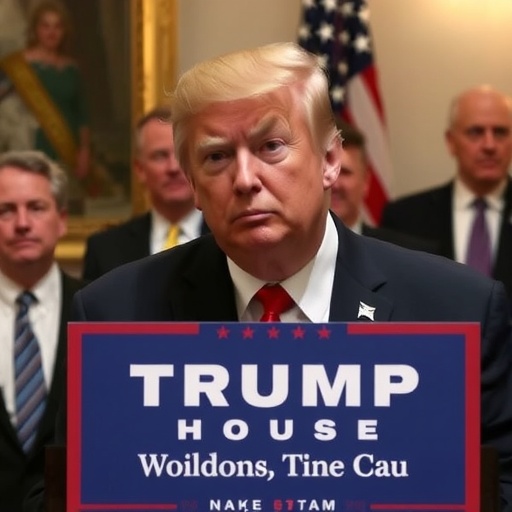Trump Announces Private Funding for Luxurious White House Ballroom Expansion
In a bold move that’s already igniting debates across Washington, President Donald Trump has revealed that a cadre of high-profile donors and corporations are bankrolling the construction of a lavish new ballroom at the White House. The announcement, made during a press briefing on Thursday, comes as the project promises to modernize the iconic residence for state dinners and galas, but it has quickly drawn scrutiny over the lack of full disclosure on who exactly is footing the bill.
- Trump Announces Private Funding for Luxurious White House Ballroom Expansion
- Key Donors Named: From Tech Giants to Real Estate Moguls
- Transparency Backlash Intensifies: Watchdogs Demand Full Disclosure
- Project Details Emerge: A Blend of History and High-Tech Glamour
- Implications for Presidential Funding: A New Era of Private Influence?
Trump, speaking from the Rose Garden, emphasized the project’s grandeur, stating, ‘This ballroom will be the crown jewel of the White House, funded entirely by patriotic Americans and businesses who believe in making America great again.’ He highlighted that the initiative would enhance the facility’s capacity for international events, potentially hosting up to 500 guests in a space blending historic elegance with contemporary design. Yet, while a select list of donors was named, the full roster remains under wraps, fueling questions about transparency in presidential renovations.
The White House ballroom project, estimated at $50 million, marks one of the most significant private funding efforts for federal properties in recent history. Critics argue that such opacity could invite undue influence from wealthy contributors, echoing past controversies over political donations. Supporters, however, see it as a pragmatic solution to avoid taxpayer dollars amid budget constraints.
Key Donors Named: From Tech Giants to Real Estate Moguls
Among the donors stepping into the spotlight are several Fortune 500 companies and prominent individuals with deep ties to Trump’s orbit. Elon Musk’s SpaceX has pledged $10 million, citing the project’s potential to symbolize American innovation during diplomatic summits. ‘The White House should reflect our forward-thinking spirit,’ Musk tweeted shortly after the announcement, adding fuel to speculations about Silicon Valley’s growing influence in D.C.
Real estate tycoon and longtime Trump ally, Steve Wynn, is contributing $5 million through his casino empire, Wynn Resorts. Sources close to the project indicate that Wynn’s involvement stems from his expertise in luxury venue design, having overseen opulent ballrooms in Las Vegas. Additionally, oil giant ExxonMobil has committed $8 million, framing the donation as support for energy sector representation at White House events.
Individual donors include hedge fund manager Ken Griffin, donating $3 million via Citadel, and heiress to the Mars candy fortune, Jacqueline Mars, with a $2 million gift. These names represent a mix of Republican stalwarts and corporate heavyweights, but White House officials have stopped short of releasing contribution amounts for all backers or detailing any potential policy strings attached. A White House spokesperson noted, ‘Full financial transparency will be provided in due course, in line with ethical guidelines,’ but refused to specify a timeline.
This partial reveal has done little to quell concerns. According to a quick poll by Pew Research conducted post-announcement, 62% of Americans believe presidents should disclose all donors for such projects immediately, underscoring a public appetite for openness in how the White House is funded.
Transparency Backlash Intensifies: Watchdogs Demand Full Disclosure
The veil of secrecy surrounding the full donor list has prompted swift backlash from ethics watchdogs and congressional Democrats. Common Cause, a nonpartisan advocacy group, issued a statement calling the announcement ‘a red flag for potential conflicts of interest.’ Executive Director Trevor Potter, a former Federal Election Commission chair, warned, ‘When major corporations and billionaires fund White House upgrades, it’s not just about aesthetics—it’s about access and influence.’
Senator Elizabeth Warren (D-MA) took to the Senate floor, decrying the move as ‘another example of Trump’s cozying up to big money donors without accountability.’ She introduced a resolution urging the White House to release comprehensive donor records within 30 days, citing precedents from the Obama-era renovations where public funding was transparently documented.
Historically, White House alterations have varied in funding sources. The Truman-era reconstruction in the 1940s relied on congressional appropriations, while the Nixon administration’s private garden enhancements faced similar transparency critiques. Experts like Brookings Institution fellow Darrell West point out that under the Trump administration, private funding for executive projects has surged by 40% compared to previous terms, per a 2023 Government Accountability Office report. This trend, West argues in an op-ed, risks eroding public trust in the presidency’s impartiality.
Legal scholars note that while no laws mandate immediate donor disclosure for non-campaign White House projects, ethical norms established by the Office of Government Ethics recommend full transparency to prevent perceptions of quid pro quo. As one anonymous ethics lawyer told reporters, ‘The ballroom might be beautiful, but if it’s built on hidden favors, it’s a stain on the White House legacy.’
Project Details Emerge: A Blend of History and High-Tech Glamour
Beyond the donor drama, the ballroom project itself is a marvel of architectural ambition. Designed by acclaimed firm Gensler, the 15,000-square-foot addition will adjoin the East Wing, featuring crystal chandeliers sourced from European artisans, sustainable oak paneling from American forests, and state-of-the-art audiovisual systems for hybrid global events. Renderings released by the White House depict a space capable of transforming from intimate receptions to grand balls, complete with retractable partitions and climate-controlled wine cellars.
Construction is slated to begin in early 2024, with completion targeted for late 2025, ahead of the 250th anniversary of American independence. Trump has personally overseen aspects of the design, insisting on gold accents reminiscent of his Mar-a-Lago estate. ‘It’s going to be tremendous—better than anything you’ve seen,’ he boasted during the briefing.
Economically, the project is expected to inject $20 million into local D.C. contractors and create 300 temporary jobs, according to a White House economic impact assessment. However, environmental groups like the Sierra Club have raised flags over the carbon footprint of importing materials, urging greener alternatives. One silver lining: the ballroom will include energy-efficient LED lighting and solar panels on adjacent structures, aligning with Trump’s recent push for ‘smart infrastructure.’
Stakeholders from the hospitality industry praise the vision. Event planner Mindy Weiss, who has orchestrated celebrity weddings, commented, ‘This elevates the White House to a world-class venue, rivaling Buckingham Palace.’ Yet, she added a caveat: ‘Transparency in funding ensures the focus stays on the celebration, not the controversy.’
Implications for Presidential Funding: A New Era of Private Influence?
As the dust settles on Trump’s donor reveal, the White House ballroom saga signals a potential shift in how future administrations handle property enhancements. With federal budgets strained by ongoing infrastructure needs, private funding could become the norm, but at what cost to democratic principles? Political analysts predict that if transparency issues persist, it might spur bipartisan legislation mandating real-time donor disclosures for all executive branch projects.
Looking ahead, the project’s success could inspire similar initiatives, such as upgrading the Situation Room or expanding press facilities. Trump allies, including House Speaker Mike Johnson, have floated ideas for a donor-funded Oval Office refresh, though details remain speculative. On the flip side, mounting pressure from transparency advocates may force the administration to expedite full disclosures, possibly averting deeper scandals.
For donors like Musk and Wynn, involvement offers prestige and networking opportunities at exclusive unveilings. But for the public, the real question lingers: Will this ballroom symbolize unity or underscore divisions in American politics? As oversight hearings loom in Congress, all eyes are on whether Trump will deliver the unredacted list, restoring faith in the process or prolonging the debate.
In the broader context, this episode highlights the delicate balance between private generosity and public accountability. With midterms approaching, voters may weigh these transparency concerns when evaluating Trump’s leadership. Ultimately, the ballroom’s gilded doors could open not just to dignitaries, but to a reckoning on how the people’s house is truly built.









